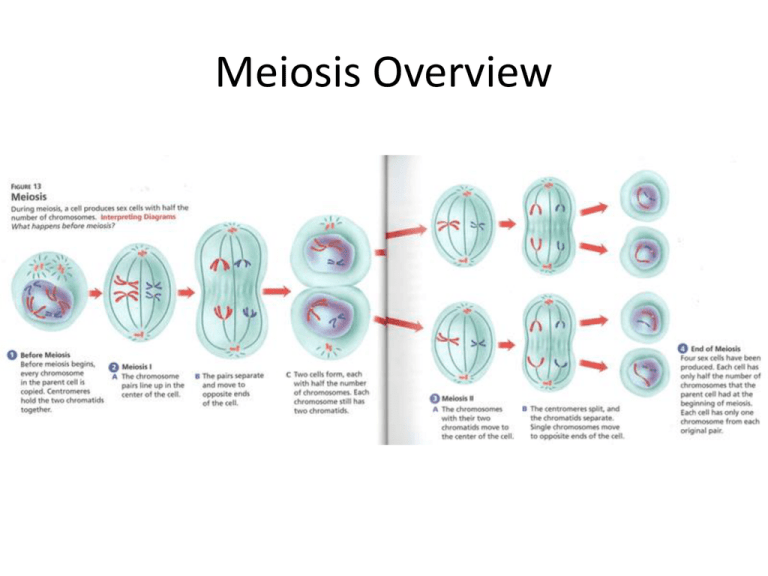Meiosis Overview
advertisement

Meiosis Overview Sexual Reproduction Defined: Gametes from two separate parents unite Meiosis: Diploid (2n) to haploid (n) cells Mechanism that allows for genetic diversity • Many eukaryotes reproduce in this manner – Plants, animals and fungi Meiosis: Prophase I • Prophase Ichromosomes become visible and nuclear membrane breaks down. • Crossing over occurs • portions of one sister chromatid are broken and exchanged with portions of the corresponding chromatid of homologous chromosome. Meiosis: Metaphase I • Homologous chromosomes move to the middle of the cell and stay together. Meiosis: Anaphase I • The homologous chromosomes are pulled apart to opposite sides of the cell via spindle fibers. • Notice that the sister chromatids are still linked together at the centromere. Meiosis: Telophase I/ Cytokinesis • A nuclear membrane reforms around the separated chromosomes • Two new __________ diploid cells are formed Meiosis II: Prophase II • The nuclear membrane dissolves around the chromosomes Meiosis II: Metaphase II • Chromosomes line up in the middle of the cell and spindle fibers attach to sister chromatids’ centromeres Meiosis II: Anaphase II • The sister chromatids are pulled to opposite sides of the pole by the spindle fibers. Meiosis II: Telophase II • The nuclear envelope forms around each set of chromosomes • Four unique haploid (1n) cells are formed Genetic Variation Created • ____________ ____________: the random distribution of homologous chromosomes • Each of the 23 pairs of chromosomes separate independently of each other • Thus, 223 (over 8 million) gametes can be produced by a single cell • Gamete formation endless possibilities 223 x 223 = over 64 trillion unique zygotes • Extremely important to the evolution of all species. Meiosis Males • Spermatogenesis: sperm production Females • Oogenesis: egg (ova) production Fertilization • Gametes of opposite sexes join to make a diploid (2n) zygote • Zygote: cell resulting from the fusion of gametes






